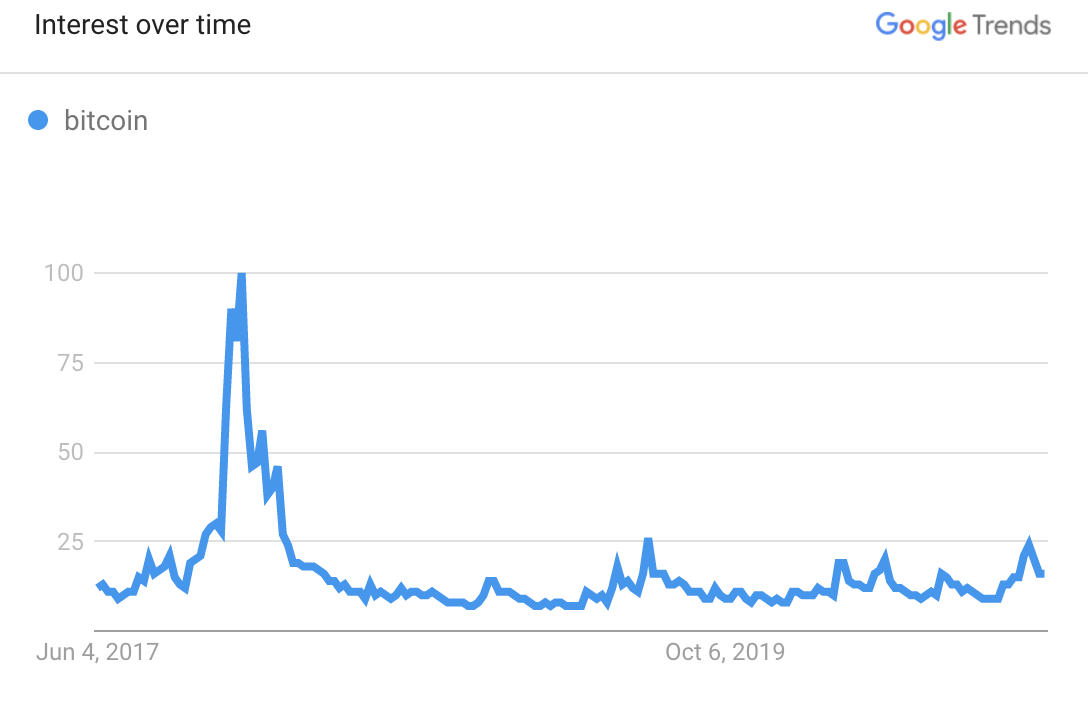Will 2021 be even bigger for Bitcoin? Here are the crypto trends to watch next year

It’s been a wild and unpredictable year in so many ways. That being said, our preview of 2020 was surprisingly accurate. DeFi boomed, institutional investors flooded in, and the halving went off without a hitch.
So what about 2021? Bitcoin hit a new all-time high in December – will the momentum carry into the new year? Is the retail crowd set to rejoin the party, or will institutional investors continue to dominate the narrative around crypto? Will Peter Schiff finally become a convert?
The Luno Team and I have dusted off the crystal balls, reviewed the events of the last year, and taken a look at what’s on the cards for the year to come. What do you think’s going to happen? These are still such early days and the possibilities are endless. The night is young and the party is only just getting started – you’ve got your invitation, make sure you don’t miss any of the fun. It’s not too late to be early.
Institutional investors continue to flock to the space…
Institutional investment in bitcoin was the headline news of 2020. Companies both big and small moved huge percentages of their cash reserves into bitcoin, including the likes of MicroStrategy, Mass Mutual, and Square. And if recent announcements are anything to go by, they’re only just getting started.
However, as exciting as it’s been to watch them pour into the space over the last year, the numbers are still relatively low. In 2021, the success (or not) of their decisions will become clear. This could motivate a whole new wave of institutional investors to follow their lead. MicroStrategy’s $425 million investment in bitcoin, for example, has already more than doubled in value (as of 18 December 2020). These are numbers that will interest any business or investor.
Furthermore, cryptocurrency and investment platforms (such as Luno) are already making it even easier for institutions to get involved. The recent news that the S&P Dow Jones Indices — a joint venture between S&P Global, the CME Group and News Corp — will debut cryptocurrency indexes in 2021, for example, should put crypto in front of even more investors on a daily basis. Exciting times!
…and will sovereign wealth funds get ready to make their move?
The next big game for bitcoin is sovereign wealth funds and governments. Will they be ready to make a public investment into bitcoin next year?
It’s actually technically already happened, albeit not directly. The Norwegian Government Pension Fund, also known as the Oil Fund, now owns almost 600 Bitcoin (BTC) indirectly through its 1.51% stake in MicroStrategy.
An open and public investment by such an entity would be a show of trust that could set off a frenzy of government FOMO. If institutional investment brought mainstream respectability to Bitcoin, imagine what the backing of a sovereign wealth fund or government would do?
Mainstream media attention returns
The recent bull run has certainly gotten people talking, but compare the media attention in 2017 to this time around. It’s been limited, to say the least. So what gives?
One reason is that this bull run has been driven primarily by institutional investors. This has often meant crypto news landing on the lesser-spotted business pages. The mainstream media’s attention has also, understandably, been elsewhere – pandemics and contentious presidential elections have a tendency to dominate the news cycle.
But there are signs this is changing. December’s new historical all-time high has brought with it a significant amount of positive coverage across major publications, including The New York Times, The Daily Telegraph, and The Independent.
If the bitcoin price continues to rise – as many suspect it will – this may drive another wave of headlines and again cement cryptocurrency firmly on the front pages. This puts cryptocurrency firmly back in the public consciousness, potentially lighting a fire under consumer demand…
…and the retail market comes back with a vengeance
A close look at recent Google Search Trends reveals an interesting quirk – the price of bitcoin managed to achieve its latest all-time high without anywhere near the level of consumer curiosity we saw in 2017.

There are a number of reasons why this could be, but chief among them is that this bull run has been driven fundamentally by institutional demand rather than retail.
An increase in media attention would certainly change this, but perhaps even more important is that it’s now easier than ever to buy bitcoin. There’s Luno supporting customers around the world, but also the likes of PayPal and Square are seeing huge success in the US. They’re currently buying the equivalent of 100% of newly-minted bitcoin just to cover the demand they’re getting from US customers.
Bitcoin owners still constitute a tiny fraction of the global population and there’s still tremendous room for growth. A booming asset, mass media attention, and easy access for the average person on the street would be a potentially explosive combination.
The real impact of the halving kicks in
The 2016 halving is widely credited with sparking the bull run that culminated in December 2017’s previous all-time high, but, obviously, this didn’t happen overnight. It took time for the impact on supply to have an impact. And there are many commentators who anticipate a similar trajectory this time around.
If (!) Bitcoin follows the previous-halving-2017 pattern, this is the 2021 Bitcoin chart ? pic.twitter.com/GyslTs8v2M
— Bit Harington (@bitharington) December 8, 2020
The most recent halving in May of 2020 saw block rewards fall from 12.5 to 6.25 bitcoin, again slowing the release of bitcoin into the market. The price of bitcoin has also increased steadily ever since. Does this mean the commentators are right? Are we set to follow the same trajectory?
There’s no easy answer to that question. The cryptocurrency space has changed since 2017, so there are no guarantees. There are also a range of other macroeconomic considerations to consider, particularly with a new government in the US, Brexit, and the COVID pandemic still knocking about. Nonetheless, should it follow the same pattern again there are huge possibilities.
Ethereum 2.0 launch leaves Ethereum in state of flux
The first phase of Ethereum 2.0 (known as Phase 0) went live on 1 December after years in the making. Phase 0, known as the Beacon Chain, will work as a coordination stage and it won’t change anything about the current usage on the Ethereum blockchain. Find out what Ethereum 2.0 is and what it means for you.
This is the beginning of a huge transition for Ethereum, one that’s unprecedented in the history of cryptocurrency. Founder Vitalik Buterin recently discussed what the next two years could look like for Ethereum on a recent Reddit Ask Me Anything. He noted that the next 24 months would see the ecosystem enter a permanent state of change that will affect all network foundations and components:
“Realistically, for the next ~2 years, Ethereum will be an ecosystem under rapid transformation […] The Ethereum ecosystem has a resolute goal of being a stable and dependable system in the long run.”
Buterin further explained that this will lead Ethereum into a new era – one set to make it a globally-usable ecosystem for companies of all sectors and industries. Next year, it will be too soon to know whether this is correct, but we’ll undoubtedly see some huge changes to the ecosystem that could have a profound impact. Be on the lookout.
Libra (Diem) launches successfully
After launching to much fanfare in 2019, Libra has been relatively quiet this year. The main news is the significant changes to its intended offering (including its name, which has now been changed to Diem). However, the association is now rumoured to be launching in January 2021 with a scaled-back offering that more closely resembles a dollar stablecoin, similar to Tether or USD Coin.
The delays and changes have led many to downplay its significance, but it’s important to remember that this is still a project driven by some of the biggest companies in the world, including the likes of Uber, Spotify, PayU, and Andreessen Horowitz, among others. We definitely wouldn’t bet against its success and we’re looking forward to watching it unfold – particularly as it could spark another wave of large companies wanting to get into the game of issuing their own coins.
The unveiling of the Libra project in 2019 was also arguably responsible for sparking a global push to develop Central Bank Digital Currencies (CBDCs) around the world. If it does launch as planned, it would essentially put them in direct competition with these CBDCs, potentially driving a government versus private company arms race…
CBDCs ready to go
In 2020, we saw a number of governments make major advances in their digital currency efforts. The Central Bank of the Bahamas even officially launched its own national digital currency and the first of its kind to have been fully deployed, the sand dollar – a digital version of the Bahamian dollar.
In terms of larger countries, the EU and the US have made progress of late. But it’s the Chinese government who looks most likely to be first out the gate. They announced the launch of their own national digital currency several years ago and recent reports have indicated that they hope to start officially issuing the digital yuan before the Winter Olympics in Beijing in February 2022.
It would seem they’re on course. In 2020, China’s central bank, the People’s Bank of China (PBOC), published a draft law appearing to provide regulatory framework and legitimacy for a forthcoming ‘digital yuan’. The draft law states that the yuan is the official currency of the People’s Republic of China whether in physical or digital form.
China also just conducted a major test of Shenzhen’s digital yuan payment system, in which nearly 47,500 residents claimed 200 yuan ($30) each in digital currency to be spent across 3,389 stores throughout the city.
How will a China CBDC change the global economy? Will it motivate the US to push forward in their own efforts?
New US administration changes crypto approach
The US’s cryptocurrency interests are likely to change whatever happens next year, with a new president incoming. Donald Trump may have publicly expressed disdain for Bitcoin, but it still flourished during his tenure. Now that Joe Biden is in, what changes will he bring?
It’s likely that it won’t all be good news. Janet Yellen, Biden’s nominee to head the Treasury Department (she’s the former chair of Economic Advisors during the Clinton Administration, and the chairwoman of the Federal Reserve System) has said in the past that “she will say outright that she is not a fan” of bitcoin. Although, given the amount of institutional money that has flooded in recently, she’s likely to see a significant amount more pushback from Wall Street that may make any bearish positions hard to maintain.
There are also many more crypto-friendly politicians in the US now. Kelly Loeffler, the former CEO of crypto derivatives platform Bakkt, has been Senator in Georgia for a while now. Arguably even more excitingly, Cynthia Lummis was recently elected to be Wyoming’s representative in the Senate, and has promised to work to reduce government debt and explain bitcoin (BTC) to her colleagues.
If the US does become more crypto friendly, will other countries follow their lead? They say when the US sneezes, the world catches a cold – what would any moves they make mean for China, India, and Europe?
Price predictions
We don’t do price predictions. Bitcoin is the future of finance. Here’s a few that leading investors have made, though, and their reasoning. We neither endorse nor condone these predictions and have collected them for your information.
Scott Minerd, chief investment officer at Guggenheim – $400,000
“Our fundamental work shows that bitcoin should be worth about $400k. We are going to, even if we have the ability to do so today, we are going to monitor the market and see how trading goes.”
Citbank’s global head of CitiFX Technicals, Tom Fitzpatrick – $300,000
“The whole existence of bitcoin has been characterised by unthinkable rallies followed by painful corrections (the type of pattern that sustains a long term trend).”
Bloomberg strategist, Mike McGlone – $170,000
“The key thing about Bitcoin this year is very simple — it just added a one to the front of the number. Remember, it was around $7,000 at the end of last year. What I’m worried about — if you look at the past performance, which is potentially indicative of the future, next year or two could add a zero to the back of the number.”
Anthony Pompliano, co-founder of Morgan Creek Capital – $100,000
“You know there are people who debate what the size of the gold market is but let’s just use easy numbers. Let’s say that it’s $8 trillion. That puts Bitcoin at, depending on how many are lost or stolen, $400,000 to $450,000 today. Do you think that Bitcoin is going to be the equivalent of the gold market? I don’t. It’s better. It’s going to capture more market.”
Robert Kiyosaki, author of “Rich Dad Poor Dad” – $50,000
“Glad I bought Bitcoin. Next stop $50 k. Wall of institutional money coming 2021. Buy below $20 k. If you missed Bitcoin, buy silver. Silver set to move due to AOC’s Green New Deal. America in trouble. Future bright for gold silver Bitcoin and entrepreneurs.”
Finally… how many times will Bitcoin die this year?
According to 99bitcoins’ Bitcoin Obituary, which documents every instance a major press publication calls Bitcoin or crypto as being ‘dead’, Bitcoin has now ‘died’ 386 times since 2010! Yet it’s still here, alive and kicking.
Last year, we predicted it would ‘die’ 15 times in 2020. It’s on seven so far – the lowest number of yearly Bitcoin ‘deaths’ in its young-but-illustrious history. In 2021, we’re going for two. People are getting smarter.
 Discover
Discover Help Centre
Help Centre Status
Status Company
Company Careers
Careers Press
Press

